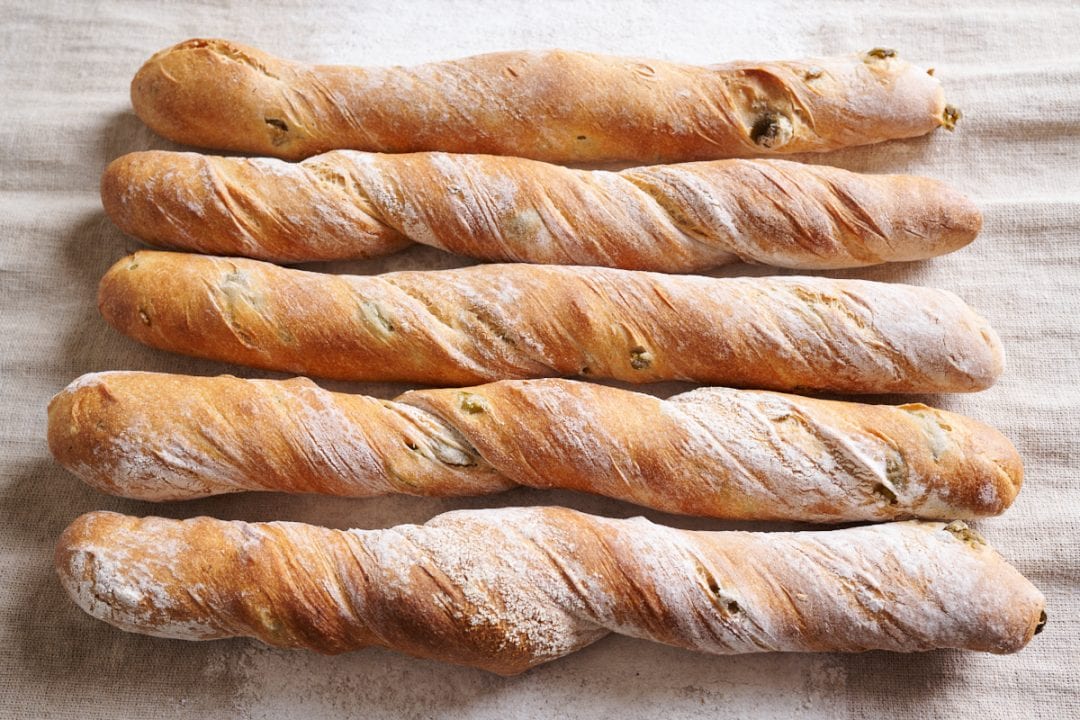With a crust that’s thin and slightly soft and a flavor profile that’s a touch salty and briny, these are hard to put down once you take a bite. The flour I use brings ample flavor (more on this in a minute), and while they look simply like twisted baguettes, I like to think of these sourdough filoncini as low-pressure baguettes. The dough is so much fun to handle—twisting and rolling and pinching—without any stress that you’re not shaping them “correctly.”
They’re fun and different, not something you’d find at your local bakery, and the flavor and texture is just as extraordinary. Sometimes baking in the kitchen can become too serious, especially if you’ve been at it a while and expectations start to creep in.
I like to think of these sourdough filoncini as low-pressure baguettes.
Well, these green olive filoncini are here to reset that. It’s an easy dough to mix, divide, shape, and twist—have fun with them and indulge in their incredible flavor!
In The Baker’s Corner (the community here at The Perfect Loaf), I posted a preview of this recipe and Mark K. called them the “Twisty Baguette Recipe for People Too Chicken to Do the Real Deal Recipe”—which I think is hilarious. But also, maybe a little true?

The beautiful thing is there is no right way with these filoncini. You can leave them straight as sticks, you can twist them aggressively into long and tight rods, or you can do as I do and twist a few times to give them some edges and a beautiful striated pattern.
I see these filoncini as a gateway into making classic baguettes. So, if you’ve been intimidated by them, start here, then tackle the baguette once you have a few filoncini under your belt (and in your belly).
They’re what I want to be when I grow old: rough around the edges, gnarly, and a little acerbic—their twists and turns exude character. They make a statement!
What Are Filoncini?
Filoncini means “small loaves” or “small strands” in Italian and is often used to describe spindly, short, or long and skinny bread that is sometimes twisted. These are also called “filoncini di pane” or “filoncini rustici” and have variations, from those including olives to tomatoes and those plain with nothing mixed in. I think of filoncini as long and twisted loaves that are very much like baguettes.
I first stumbled on these during my recent trip to Italy. A small bakery had long, thin, and twisted sticks with olives, and after trying a few, I knew I had to make my sourdough version when I returned home. That’s how the best trips (especially food-focused trips) end, right? A head full of culinary ideas and a to-do list much longer than when you left.

Flour Selection
A lot of that flavor comes from the long fermentation time, yes, but also the flour. I’m using the Hayden Flour Mills The Perfect Loaf flour blend as 100% of the flour in this recipe. This blend of fresh flour has a hefty portion of high-extraction flour and rye. The rye gives the blend a wholesome slant and a touch of sweetness.
I bake with our collaboration flour often here and I love that you can open a single bag of flour and have flavor practically springing from the bag (take notice of the aroma as you mix this dough!).
Here’s the flour breakdown:
| Flour | Percentage |
|---|---|
| White bread flour (sifted hard red spring wheat) | 70.0% |
| Rouge de Bordeaux Type-85 Flour (high-extraction flour) | 25.0% |
| Gazelle Rye (stone-milled 100% whole-grain rye flour) | 5.0% |
If you’d like to know more about how I developed this blend and worked with Hayden Flour Mills (my neighbor in Arizona), check out my recipe, where I use it in country-style sourdough bread.

Baking Schedule
My recipe for these filoncini uses a ripe sourdough starter instead of a levain, making the timeline a bit shorter for the recipe. Additionally, and in keeping with the theme of fun and easy, this is a direct bake, meaning the dough is baked the day it’s mixed.
No overnight cold fermentation required.
If you’d like to create a dedicated levain for this recipe, check out my starter and levain quicksheet, which has several options—pick one!

Green Olive Filoncini Recipe
Use baker’s percentages to modify this formula (e.g., add more olives or olive oil or scale it up and down).
Vitals
| Total dough weight | 1,800 grams |
| Prefermented flour | 8.8%* |
| Sourdough starter in final dough | 17.5% |
| Hydration | 66.0% (does not include olive oil) |
| Yield | 6 x 300g filoncini |
*Since there is no levain for this recipe, the prefermented flour is calculated using half of the sourdough starter flour (since my starter is about half flour and half water) to the total flour in the recipe.
Total Formula
Desired dough temperature: 76°F (24°C) (see my post on the importance of dough temperature).
| Weight | Ingredient | Baker’s Percentage |
|---|---|---|
| 868g | The Perfect Loaf Bread Flour (Hayden Flour Mills custom blend) | 100.0% |
| 165g | Green olive, pitted and coarsely chopped or broken | 19.0% |
| 26g | Extra-virgin olive oil | 3.0% |
| 530g | Water 1 | 61.0% |
| 43g | Water 2 | 5.0% |
| 16g | Fine sea salt | 1.8% |
| 152g | Ripe sourdough starter, 100% hydration | 17.5% |
Green Olive Filoncini Method
1. Mix – 9:00 a.m.
I used my KitchenAid stand mixer to mix and knead the dough efficiently. However, it’s also possible to mix this dough by hand using slap-and-fold kneading or folds-in-the-bowl techniques. Just be sure to hold back the olive oil until the dough is significantly strengthened, smooth, and elastic.
To the bowl of a stand mixer fitted with the dough hook attachment, add the flour, water, salt, and ripe sourdough starter. Mix on low speed (STIR on a KitchenAid) for 1 to 2 minutes until the ingredients come together, no dry bits remain, and the sides of the bowl are clean. This is a rather cohesive and firm dough because of the moderate hydration.
Next, mix on medium speed (2 on a KitchenAid) for 4 to 5 minutes until the dough smooths and begins to cling slightly to the hook.
Let the dough rest in the bowl for 10 minutes.
Return the mixer to medium speed and mix for 3 to 4 minutes until the dough gains more strength and clings again to the dough hook.
Reduce the mixer speed to low speed and add slowly stream in the Water 2, adding it in only if the dough is cohesive after each addition (if the dough gets sloppy, overly wet, or breaks apart, omit the remainder of the water). Then, with the mixer still running, slowly stream in the olive oil. Use a spatula to scrape the sides of the bowl as needed. Once all of the oil is added, about 3 minutes later, the dough will be in a cohesive ball in the mixing bowl with the sides clean.
Transfer the dough to a bulk fermentation container and cover.
2. Bulk Fermentation – 9:30 a.m. to 12:30 p.m. (3 hours)
At a warm room temperature of 74-76°F (23-24°C), bulk fermentation should take about 3 hours. During this time, give the dough a single set of stretches and folds 30 minutes after the start of bulk fermentation. At the same time, we’ll incorporate the olives into the dough.
Before you give your dough its first set of stretches and folds, spread about 1/4 of the olives over the top of the dough (see below). Then, grab one side of the dough and stretch it over to the other. Next, spread another 1/4 of the olives to the new top. Rotate the bowl 180° and perform another stretch and fold. Spread on another 1/4 of the olives, rotate the bowl 90°, and do another stretch and fold. Finally, spread on the last of the olives, turn the bowl 180°, and do one last stretch and fold.



After this set, try to have the dough neatly folded up in the bowl with all inclusions tucked inside (it’s okay if there are some sticking out, as you see in my dough above).
Let the dough rest, covered, for the remainder of bulk fermentation.
3. Divide and Preshape – 12:30 p.m.
At the end of bulk fermentation, the dough should be moderately risen and slightly puffy to the touch but not excessively bubbly or weak (see below).

To make the final shaping of these filoncini easier and more consistent, I like to gently preshape the divided dough pieces into small rounds.
Lightly flour the top of the dough in the bulk fermentation container, then scrape it out to an un-floured work surface. Divide into six 300g pieces (it’s okay if the last piece is a little below 300g) and preshape the dough into gentle rounds.

Let the preshaped dough rest for 30 minutes, covered with a large piece of reusable plastic or slightly damp kitchen towel.
4. Shape – 1:00 p.m.
After 30 minutes, the preshaped rounds will have relaxed just a bit. We will now shape each piece into a stubby tube approximately 6″ long. I use the same process as when shaping baguettes to shape these into tubes, except I do not roll them out as far and do not taper the ends.
Be sure to scroll to the end of this step to see a shaping video.
Prepare a board or space on your work surface with a couche (baker’s linen) or a large kitchen towel. You’ll place the shaped filoncini on top of the cloth in little channels designed to hold the dough (more on this in a moment).
At one side, where you will start laying down preshaped filoncini, roll a section so that it stands up by itself, creating a strong edge. Then thoroughly and evenly dust flour on a 3- to 4-inch-wide strip down the couche, from farthest from you to nearest, where the first piece of shaped dough will sit.




To shape each filoncini:
- Lightly flour the top of a relaxed round and your work surface
- Using a bench scraper, pick up and flip over the floured round
- Fold the top of the circle down to the middle (upper-left, above)
- Flip the piece of dough 180° and fold the new top of the circle down to the middle (upper-right, above)
- Using both hands, fold the dough down in successive motions to make a round (bottom-left, above)
- Finally, use both hands to evenly roll out the tube to about 6-inches (bottom-right, above)
Once you’ve shaped a piece, place it in the flour-dusted channel on the couche, seam side up. Then, using both hands at the edges, pick up and drag a little of the couche toward the dough (like making a pleat in the couche) so that it forms a matching wall of the channel to hold the dough while it’s proofing. Once the new wall is formed, it will look like the dough is nestled between two straight walls.
See the video below for more help with shaping and placing the dough on the couhe.

Flour a new strip down the couche on the other side of the newly formed wall in preparation for another piece of dough. Repeat this process for all the preshaped rounds.
I like to cover the dough on the couche with a large piece of reusable plastic (or the ends of the couche if it reaches) to prevent the dough from excessively drying out during proofing.
Watch the quick video below for my step-by-step approach to shaping filoncini.
5. Proof – 1:30 p.m. to 3:00 p.m.
Proof the shaped filoncini dough for about 1 1/2 hours at warm room temperature, 74-76°F (23-24°C).
At this time, you might also want to set a timer for 30 minutes. You’ll need to preheat your oven one hour before baking.
6. Twist and Bake – 3:00 p.m. (preheat oven at 2:00 p.m.)
Thirty minutes before you want to bake, preheat your oven to 450°F (232°C) with a baking stone or baking steel in the bottom third of the oven. After proofing for 1 1/2 hours, the dough will be puffed up and soft to the touch but not sticky. It should pass the poke test when it’s ready for baking.
TIP: To get the most contrast in the twists after baking, before removing the pieces of dough from the couche, lightly sift white flour over the top of the dough pieces. This way, the dough will have white flour on the bottom (where it’s resting on the couche) and the top.
Prepare a pizza peel with parchment paper matching the width of your baking surface.
Grab one end of the couche and pull it out, moving the piece of dough away from the rest. Using both hands, grab the piece of dough very gently and transfer it to the parchment paper. Repeat until three pieces are on the parchment paper on the pizza peel.
I can comfortably fit 3 filoncini on my baking steel, so I break the baking step into two sessions. After transferring 3 pieces of dough to the pizza peel, place the remaining 3 pieces into the fridge, covered. If you’re couche was on a board, move that to the fridge, or, place the remaining three pieces on a piece of parchment paper on top of a cutting board or inverted baking sheet.
To twist each piece, imagine your hands like the letter “C,” grabbing a thick pipe. You want to maintain this “C” shape while you twist, avoiding excessive clamping or pinching. Grab the dough and perform successive twists, moving from the center to the edges.



Remember: there’s no right way to do this! Twist and have fun with it. Even if the dough gets pinched, it’ll still puff up and be delicious 🙂
Transfer the dough onto the baking surface in the oven using the parchment paper. Next, steam the oven and bake for 20 minutes. Remove the steaming pans and bake for another 20-25 minutes until done. Keep an eye on these in the last 10 minutes to ensure they don’t color too much; they should be golden brown.
Cool on a rack. Repeat the process for the remaining pieces of dough in the fridge.
Due to the olive oil in the dough, these will keep well for a few days on the counter, uncut. After a few days, transfer them to a bread box or bag to keep them fresh.
Print
Green Olive Filoncini (Twisted Baguettes)
- Author: Maurizio Leo
- Prep Time: 6 hours
- Cook Time: 45 minutes
- Total Time: 6 hours 45 minutes
- Yield: 6 loaves
- Category: Lunch, Dinner, Snack
- Cuisine: Italian
Description
These fun, long sticks are packed with flavor thanks to the salty green olives and fruity olive oil (which also gives them a wonderfully soft-ish crust). Use them for sandwiches, appetizers, or just torn and dunked into more olive oil at any time of the day.
Ingredients
- 868g The Perfect Loaf Bread Flour (Hayden Flour Mills custom blend)
- 165g Green olive, pitted and coarsely chopped or broken
- 26g Extra-virgin olive oil
- 530g Water 1
- 43g Water 2
- 16g Fine sea salt
- 152g Ripe sourdough starter, 100% hydration
Instructions
- Mix – 9:00 a.m.
Add the flour, water, salt, and ripe sourdough starter to the bowl of a stand mixer fitted with the dough hook attachment. Mix on low speed (STIR on a KitchenAid) for 1 to 2 minutes until the ingredients come together, no dry bits remain, and the sides of the bowl are clean. Next, mix on medium speed (2 on a KitchenAid) for 4 to 5 minutes until the dough smooths and begins to cling slightly to the hook. Let the dough rest in the bowl for 10 minutes. Return the mixer to medium speed and mix for 3 to 4 minutes until the dough gains more strength and clings again to the dough hook. Reduce the mixer speed to low speed and slowly stream in the Water 2, adding it only if the dough is cohesive after each addition (if the dough gets sloppy, overly wet, or breaks apart, omit the remainder of the water). Then, with the mixer still running, slowly stream in the olive oil. Use a spatula to scrape the sides of the bowl as needed. Once all of the oil is added, about 3 minutes later, the dough will be in a cohesive ball in the mixing bowl with the sides clean. Transfer the dough to a bulk fermentation container and cover. - Bulk Fermentation – 9:30 a.m. to 12:30 p.m. (3 hours)
At a warm room temperature of 74-76°F (23-24°C), bulk fermentation should take about 3 hours. Give the dough a single set of stretches and folds during this time. At the same time, we’ll incorporate the olives into the dough. Before you give your dough its first set of stretches and folds, spread about 1/4 of the olives over the top of the dough (see below). Then, grab one side of the dough and stretch it to the other. Next, spread another 1/4 of the olives to the new top. Rotate the bowl 180° and perform another stretch and fold. Spread on another 1/4 of the olives, rotate the bowl 90°, and do another stretch and fold. Finally, spread on the last of the olives, turn the bowl 180°, and do one last stretch and fold. Cover and let rest the remainder of bulk fermentation. - Divide and Preshape – 12:30 p.m.
Lightly flour the top of the dough in the bulk fermentation container, then scrape it out to an un-floured work surface. Divide into six 300g pieces (it’s okay if the last piece is a little below 300g) and preshape the dough into gentle rounds. Let the preshaped dough rest for 30 minutes, covered with a large piece of reusable plastic or slightly damp kitchen towel. - Shape – 1:00 p.m.
Prepare a board or space on your work surface with a couche (baker’s linen) or a large kitchen towel. You’ll place the shaped filoncini on top of the cloth in little channels designed to hold the dough (more on this in a moment). For each piece of dough, lightly flour the top of a relaxed round and your work surface. Using a bench scraper, pick up and flip over the floured round. Fold the top of the circle down to the middle. Flip the piece of dough 180° and fold the new top of the circle down to the middle. Using both hands, fold the dough down in successive motions to make a round. Finally, use both hands to evenly roll the tube to about 6-inches. Place it in the flour-dusted channel on the couche, seam side up. Then, using both hands at the edges, pick up and drag a little of the couche toward the dough (like making a pleat in the couche) to form a matching wall of the channel to hold the dough while it’s proofing. Once the new wall is formed, it will look like the dough is nestled between two straight walls. Repeat for all pieces. - Proof – 1:30 p.m. to 3:00 p.m.
Proof the shaped filoncini dough for about 1 1/2 hours at warm room temperature, 74-76°F (23-24°C). - Twist and Bake – 3:00 p.m. (preheat oven at 2:00 p.m.)
Thirty minutes before you want to bake, preheat your oven to 450°F (232°C) with a baking stone or baking steel in the bottom third of the oven. Prepare a pizza peel with parchment paper sized to match your baking surface. Gently transfer three pieces of dough from the couche to the parchment. Place the remaining dough in the fridge, covered. Twist each piece by holding the dough in a “C” shape, twisting from center to edges. Transfer the dough to the oven using the parchment, steam, and bake for 20 minutes. Remove steaming pans and bake for another 20-25 minutes until golden brown, monitoring the last 10 minutes. Cool on a rack and repeat with the remaining dough.
Notes
Instead of green olives, any black olives (including Kalamata) would be a great substitution.
What’s Next?
Now that you have these under your belt try my Khorasan baguettes! Or, if you’re looking for another easy Italian-themed bake, my sourdough friselle (rusks) are lovely and keep for months.
Buon appetito!





